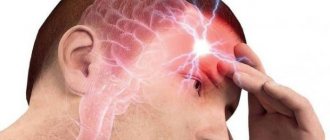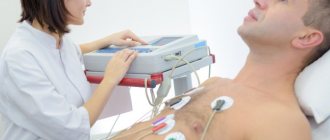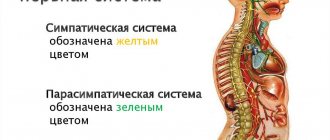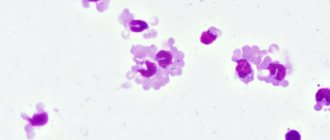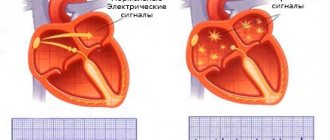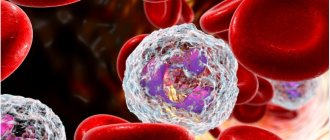What is VSD?
The diagnosis of VSD is made to a patient when he exhibits vague complaints and symptoms that do not fit the description of any disease. Among themselves, specialists quite often call this condition in their patients “diagnostic garbage”, and an entry may appear on the card - psycho-vegetative syndrome, vegetative-vascular dystonia, neurocirculatory dystonia, SVD of the heart.
But in reality the situation is much worse than it looks on paper. The patient needs to clearly understand that such diagnoses indicate that:
- As a result of the diagnosis, the doctor did not find the real reason that causes these symptoms. And recording the VSD allows us not to conduct further research.
- The person is not given adequate treatment, in which case the condition worsens. And those medications that were prescribed are just an imitation of treatment. In fact, a person’s rights to cure in this case are actually limited, because he has a diagnosis, which is not a diagnosis at all. It turns out to be such a vicious circle.
- The result of such unnecessary treatment does not improve the condition, but side effects from taking medications are to be expected.
If this diagnosis is made during the first visit to the doctor, then it is necessary to change the doctor and find a qualified neurologist who will certainly conduct a comprehensive examination, study the patient’s condition and be able to get to the causes of the problem. In addition, he will have to involve other specialists to clarify the final diagnosis.
Pregnancy in women suffering from VSD
For women suffering from VSD, pregnancy raises many questions that cannot but worry them. Eg:
- Is pregnancy compatible with the disease?
- Are there any peculiarities of its course?
- Is there a chance that VSD will be inherited by the baby?
- Will pregnancy provoke an exacerbation of the disease due to hormonal changes?
- What to do with therapy with psychotropic drugs if they are prescribed: cancel or continue treatment.
To eliminate doubts it is necessary to dispel them.
The course of pregnancy with a diagnosis of VSD
Here we can say unequivocally - the course of pregnancy will not differ from the standard one. VSD does not in any way affect the pregnancy of the baby. Toxicosis and gestosis are likely, but this will not depend on the diagnosis of “vegetative-vascular dystonia”, but on the individual characteristics of the expectant mother and her general health indicators. It is worth saying that a woman, at the level of instincts, tries to protect her unborn baby, so the symptoms of VSD usually become less noticeable or disappear altogether.
If a woman has no contraindications to pregnancy, then VSD is not a reason to refuse the opportunity to become a happy mother.
Is VSD inherited?
VSD is not a hereditary disease. A child may have a predisposition to disturbances in the nervous system, but it is reliably known that the children of women suffering from vegetative-vascular dystonia, in 70 percent of cases, before reaching adulthood, never experienced a single symptom characteristic of VSD.
Of course, the baby, while in the womb, is exposed to all its conditions. Therefore, a pregnant woman needs to take maximum care, eat healthy foods, not take medications unless absolutely necessary, not experience stress, not be nervous, and lead a healthy lifestyle that excludes bad habits. It is necessary to carefully monitor compliance with all these conditions before reaching 13 weeks of pregnancy.
Any exposure to harmful factors can cause a malfunction in the baby’s central nervous system, which, in turn, can provoke VSD in the future.
Will the condition of a patient diagnosed with VSD worsen during pregnancy?
Usually, women diagnosed with vegetative-vascular dystonia feel better during pregnancy, childbirth and after it. The general condition improves, panic attacks practically disappear. This is a consequence of the fact that the body protects the baby by mobilizing the entire woman’s body. In addition, hormonal changes have a beneficial effect on the health of the expectant mother.
It is unlikely that you will be able to avoid headaches, attacks of heartburn, or increased blood pressure, but these signs are also typical for the pregnancy of healthy women, so this can hardly be considered a deviation from the norm.
The main thing is to immediately, at the very beginning, get rid of bad thoughts and tune in to the positive. You should try to let go of the situation and the body will cope on its own.
treatment of vegetative-vascular dystonia during pregnancy
It is better to avoid using antidepressants and psychotropic drugs while expecting a baby. But it is permissible to use them occasionally if there is a threat to the life of the expectant mother.
By using antidepressants during pregnancy, a woman threatens to provoke withdrawal syndrome in her baby after birth, which will definitely lead to depression of the central nervous system and increase the risk of developing defects and miscarriage.
As soon as you start planning a pregnancy, you should remember that during pregnancy and breastfeeding you will have to give up antidepressants, since their benefits for the mother cannot be compared with the harm that will be caused to the child. That is, bearing a child, childbirth and feeding presuppose a complete refusal to treat VSD.
Childbirth with VSD
Childbirth with a diagnosis of VSD takes place as usual, as in any healthy woman, if the general health of the woman in labor allows natural labor.
There's definitely nothing to be afraid of here. Author: K.M.N., Academician of the Russian Academy of Medical Sciences M.A. Bobyr
Main set of symptoms
Since many diseases can be hidden under VSD, the list of complaints can be very diverse:
- From the cardiovascular system, manifestations such as rapid heartbeat, an unpleasant sensation in the chest area, pressure changes with the formation of a hypertonic and hypotonic state, increased sweating, a feeling of cold extremities, hot flashes can be observed.
- From the side of the respiratory system, it is observed that it becomes difficult for a person to take a breath, shortness of breath becomes active, a feeling that there is not enough air, which can cause pre-fainting conditions.
- The gastrointestinal tract produces stool disorders (this can be either diarrhea or constipation), attacks of nausea, loss of appetite, increased gas formation in the intestines, dull pain localized in the lower abdomen, and a feeling of dry mouth.
- Genitourinary disorder most often manifests itself as an increased urge to urinate, decreased potency in men and decreased libido in women.
- Neurological symptoms include dizziness, migraine, headaches, the formation of fear, lightheadedness, poor blood circulation in the brain, which causes changes in cognitive functions (decreased attention, reaction speed, concentration), tremors in the hands, impaired levels of muscle tension, paresthesia, pain in the muscles, which can be localized in a variety of places, changes in normal sleep.
- Mental disorders also manifest themselves. They can be expressed by neuroses, a feeling of anxiety, excessive tension, stiffness, a person is not able to completely relax, he becomes characterized by fussiness, a sense of self-involvement, memory decreases, and various fears appear that cannot be formulated.
- Thermoregulation is also impaired, which may result in a feeling of chills.
As can be seen from the above list, vegetative-vascular dystonia can be expressed in the form of any disease of an organ and system, as well as the pathology of their development. That is why it is difficult to correctly diagnose and prescribe the correct treatment for VSD. In addition, panic attacks, stress and neuroses are frequent additional companions of this deviation.
Symptoms of vegetative-vascular dystonia
The syndrome is characterized by many different manifestations. Every pregnant woman needs to listen to her body. This will help distinguish the symptoms of vegetative-vascular dystonia from those that may indicate other disorders in the body. With an exacerbation of VSD, a pregnant woman complains of heart problems and dizziness, which will be discussed in detail below, and the following phenomena:
- feeling of constant overwork;
- bloating and other disorders of the gastrointestinal tract;
- numbness of the limbs and tingling in them;
- nausea;
- sleep problems;
- trembling in hands;
- labored breathing;
- frequent urination;
- weather dependence;
- regular changes in body temperature;
- irritability, tearfulness;
- disorders in the sphere of intimate life;
- attacks of causeless anxiety, panic;
- anemia and fainting in thin girls;
- sweating and swelling in overweight women.
- How to effectively treat vegetative vascular dystonia - necessary advice and medications for the treatment of VSD
Heart problems
The disease always causes disruption of the cardiovascular system. A pregnant woman exhibits one or more of the following syndromes:
- Cardiological. This condition is sometimes mistaken for coronary heart disease. Accompanied by a feeling of pain in the chest.
- Tachycardic. Vegetative-vascular dystonia is sometimes accompanied by rapid heartbeat.
- Bradycardic. Low heart rate with VSD. Provokes a feeling of weakness.
- Arrhythmic. Violation of the rhythm of heart contractions.
- Hypertonic or hypotonic.
Dizziness
The most common symptom of the syndrome. Dizziness indicates a disruption of the nervous and vascular system. As a rule, it is accompanied by a feeling of lack of air and is especially intensified during moments of panic attacks. If a fragile, thin girl is dizzy, this can even cause fainting. If dizziness occurs, you should immediately sit down, relax, and rest a little. If it does not go away, then it is better to consult a doctor.
Features of diagnosis and diagnosis
It must be taken into account that such a diagnosis as vegetative-vascular dystonia does not exist in the International Classification of Diseases (ICD). Most doctors prefer to use other, similar analogues:
- Disorder of the autonomic (vegetative) nervous system.
- Dysfunction of the autonomic nervous system is somatoform.
A responsible qualified doctor, to whom a patient approaches, with a certain part of the symptoms from the above list, will carry out all the necessary manipulations and collect anamnesis for the correct diagnosis.
He should carry out the analysis taking into account:
- Gender, age, constitution and other parameters of the patient. And determine the possible range of diseases to which the nature of this symptom complex will fit.
- Prescribe the necessary treatment, from the doctor’s point of view, and monitor the process.
- It is important to schedule a consultation with a psychotherapist if necessary. And do it as quickly as possible.
If the prescribed treatment does not bring visible results, then it is necessary to continue the examination to identify the disease that is showing symptoms.
Treatment
Therapeutic measures consist of a set of effective methods, each of which is selected individually. Since most of the occurrences of VSD occur due to stress, it makes sense to pay attention to ways to combat them:
- normalization of sleep;
- rejection of bad habits;
- building an adequate work and rest regime, if necessary, the issue of changing jobs is considered;
- nutritious nutrition in compliance with the meal schedule;
- performing special sets of physical exercises, therapeutic exercises, yoga;
- work with a psychologist (individual or group classes, psychological trainings, consultations);
- physiotherapeutic procedures (massage, electrophoresis, contrast and therapeutic showers, etc.);
- Spa treatment.
All of the above methods are quite effective; when used, not only the disappearance of VSD symptoms is noted, but also an overall positive effect on the body as a whole.
Manifestation in children
It is necessary to take into account the fact that children's pulse is always faster than adults. Therefore, you should not focus on this parameter when diagnosing VSD.
But you need to be wary when:
- The appearance of a rash, dry skin, possible swelling.
- There is a feeling of restlessness, anxiety and nervousness.
- Breathing changes its character. It becomes intermittent, excessively frequent, slow.
- Decreased appetite.
- The occurrence of problems with the gastrointestinal tract, for example, gastritis or duodenitis occurs by adolescence (puberty).
- An attack of nausea accompanied by vomiting.
- Changing the stool.
- Muscle tone is impaired.
- Fluctuations in body temperature.
- Anxiety and emotional instability arise.
- A wide variety of diseases can also develop, including such serious ones as heart defects and pathology of the heart muscle.
- The hormonal system begins to work incorrectly. Its pronounced effect is changes in the timing of puberty. For many boys it is delayed. In turn, in girls, on the contrary, it occurs earlier. Signs of this are early menstruation.
If such disorders occur, it is recommended to consult a doctor as soon as possible. It is necessary to understand that vegetative-vascular dystonia should be treated not by one specialist, but by several. A neurologist, pediatrician, cardiologist, gynecologist, and psychiatrist should be involved. Only such an integrated approach has a chance of success and will relieve the child of unpleasant symptoms and will not interfere with development.
Causes of panic disorder in pregnant women
Panic attacks during pregnancy can occur for several reasons. First, there is an ongoing panic disorder that was not treated before pregnancy. At the same time, there are many cases where panic attacks during pregnancy went away completely and no longer bothered the woman. And vice versa - a long-term panic disorder during pregnancy may return. It also happens that the first episode of the disease occurs after pregnancy.
Both the relapse and the onset of the disease in the expectant mother are explained by the fact that the woman’s hormonal system becomes unbalanced with the onset of pregnancy, anxiety increases, and fear for the unborn baby appears. All this is stress for a woman, and it is this that is the trigger for the development of panic disorder, and an anxious, unstable state while waiting for motherhood is fertile ground for it.
Panic attacks during pregnancy are not uncommon, so there are effective treatment methods specifically for expectant and nursing mothers that can save a woman from panic attacks without harm to the baby.
VSD of hypotonic type
Sometimes a complex of symptoms occurs when the autonomic nervous system of an adult or child acts on the blood vessels in such a way that a hypotonic background is formed.
The most pronounced symptoms in this group of patients are:
- Conditions with depression, as one feels constant fatigue, weakness, apathy and lethargy.
- There are frequent mood changes.
- Breathing levels may be abnormal. It will be more sluggish.
- A severe panic attack also often accompanies this type of VSD.
- A person has a constant feeling of lack of vitality, which manifests itself in the inability to perform various types of activities. Any work becomes a burden.
- A sudden change may also affect heart rate.
- A person constantly feels unwell, during which sudden loss of strength occurs.
To normalize this condition, in addition to using traditional conservative treatment methods that are designed to eliminate the existing problem, it is also necessary to change your lifestyle, increasing your daily routine with physical activity, and try to increase your time spent in the fresh air. To do this, you always need to find an opportunity at any age. Maintain a balance of external conditions, that is, eliminate irritating factors.
Prevention
Timely detection, treatment and consistent prevention lead to the disappearance or significant reduction of the main manifestations of vegetative-vascular dystonia (in 80-90% of cases). A full range of measures allows you to restore the body’s adaptive capabilities. A significant role in this is played by lifestyle correction, which includes normalizing the work regime, eliminating physical inactivity, providing daily dosed physical activity, limiting excessive emotional influences, and proper nutrition. An integral component of the prevention of vegetative-vascular dystonia is rest. It is extremely important to travel outside the city regularly. The best option would be to undergo treatment in a sanatorium, a stay in which not only allows you to fully relax from constant physical and psycho-emotional stress, but also provides the opportunity to undergo special procedures in one place.
If you are looking for a way to effectively treat and prevent VSD or want to undergo a comprehensive examination, contact the ABC-Medicine clinic. To contact specialists, dial our Moscow number +7.
VSD of the hypertensive type
As the name implies, this type is characterized by the presence of high blood pressure in a person. This condition is more dangerous, unlike hypotension. High blood pressure can cause significant damage to organs, especially the brain. This happens due to increased blood flow to the cervical region and head. During hypertensive crises, a stroke can occur. That is why it is necessary to treat VSD, but remember that self-medication can only bring harm. Therefore, it is recommended to contact qualified specialists; only with their help can positive results be achieved.
In addition, with the hypertensive variant of the disease, trembling in the limbs, stiffness in the chest, and a decrease in the intensity of sensitivity in the limbs are observed.
It is necessary to note that in the case when a person’s parasympathetic system begins to predominate over the sympathetic, the patient will begin to be in a state of relaxation and lethargy.
How to help a pregnant woman with panic disorder
The main tool for combating panic attacks in pregnant and lactating women is psychotherapy. Antidepressants used as maintenance therapy are extremely undesirable in the first trimester, and in the second and third they are prescribed only for severe panic disorder, when the benefit to the mother is higher than the risk to the fetus (the woman’s condition requires it).
It is working with a psychotherapist that will help to identify the hidden reasons that caused panic disorder. Treatment is carried out based on these reasons - negative attitudes are worked through and replaced with positive ones, hidden fears are revealed, self-esteem and self-confidence are improved.
The specialist will explain why panic attacks occur during pregnancy, what to do when an attack approaches and during it, and teach relaxation and control over thoughts and emotions. These skills will help stop an impending attack in the bud. Gradually, the frequency and intensity of attacks will decrease, and pregnancy and motherhood will give only positive emotions. Do not self-medicate, contact a professional to give peace and happiness to yourself and your baby.
We know how to help expectant and nursing mothers suffering from panic disorder. The Center’s doctors have the most modern and effective methods of psychotherapy in their arsenal, which will help you completely get rid of panic attacks without the use of antidepressants. A mother’s good mood and calmness are the key to the harmonious development of the baby. Therefore, you don’t need to fight fear on your own - come, we will definitely help you.
Treatment of vegetative-vascular dystonia
Treatment of vegetative-vascular dystonia in adults and children will be individual. This is due to the fact that the functioning of organs and systems differs at different ages. And, in order for the effects of medications, as well as additional effective procedures, to have a positive effect on the functioning of the autonomic nervous system, diagnosis is necessary. And it must be carried out in the most thorough manner. After all, in order to cure a disease, it is necessary, through a comprehensive analysis and collection of anamnesis, to identify the real internal state of each organ and system. Determine how much this or that part of the body suffered.
Diagnostics are carried out using a variety of methods, including hardware ones:
- Ultrasound of various organs.
- MRI of blood vessels and brain.
- Chest X-ray.
- Determination of the condition of the gastric mucosa - with FGS.
Only after passing all the necessary examinations and after a comprehensive analysis can you begin to treat vegetative-vascular dystonia.
Causes and mechanism of action
Hereditary predisposition is considered one of the main causes of vegetative-vascular dystonia (especially in childhood). In combination with unfavorable external factors, it affects the state of the brain (in particular the hypothalamus), increasing the manifestations of the syndrome. The development of psychoneurological disorders leads to excessive activation of some processes and inhibition of others. This state of the body has a negative impact on various systems and organs. In adolescence, this is especially evident at the neurophysiological level. The causes and symptoms of VSD in adults are particularly influenced by hormonal changes.
Among the risk factors for vegetative-vascular dystonia, the following are usually distinguished, having the most powerful effect:
- disruptions in the functioning of the body (endocrine disorders, pregnancy, menopause, etc.);
- consequences of past infections, injuries, as well as the presence of chronic diseases;
- bad habits (smoking, drinking alcohol, etc.);
- emotional overload, stress, etc.
Traditional drug treatment
It is necessary to take into account that there is no unambiguous group of funds for VSD. Doctors are guided by the situation that each patient demonstrates. Depending on different conditions, different courses of medications may be recommended.
But, in the vast majority of cases, it includes Corvalol, a group of antidepressants, tranquilizers. They are used to achieve a sedative effect. Taking them improves mood, reduces stress, irritation and insomnia. In addition, due to the fact that when taking sedatives, the effect of muscle relaxation is achieved, the manifestation of pain becomes less pronounced.
But, it is necessary to pay attention to the possibility of harmful effects and side effects. Naturally, in a healthy body, the use of drugs from these groups is unlikely to cause a mixed negative effect. But, in a difficult situation, for example, when the patient is pregnant, or the patient is a child, it is necessary to avoid the effects of certain components on the body. Therefore, basically, doctors in such cases help their patients by prescribing herbal teas or herbal preparations.
Plants such as hawthorn, motherwort or other substances help. If you take them periodically, then between courses you must take a certain pause, which will be indicated by your doctor. A pause should be mandatory, since plants are the same medicines as drugs from the pharmacy. The regimen of use must either be prescribed by a doctor, or the patient uses the source of information indicated on the package.
Diagnosis and treatment
Diagnosis of this disease includes:
- consultation with a neurologist;
- psychiatrist consultation;
- examinations by specialists to eliminate the root cause.
Treatment of VSD during pregnancy is prescribed only by a doctor after the woman has undergone a comprehensive examination and the cause of the pathology has been established.
At the first stages, therapy will be aimed at normalizing the woman’s psycho-emotional state without the use of medications. It includes:
- reducing the number of psychological stimuli;
- reduction of physical activity;
- adherence to daily routine;
- normalization of the period of sleep and wakefulness;
- walks in the open air;
- proper nutrition and drinking regime.
Following these recommendations helps put dystonia into remission.
If an exacerbation of VSD occurs during pregnancy, acceptable drug treatment is selected. It involves taking special sedatives and antidepressants.
If dystonia develops against the background of high blood pressure, additional medications are prescribed to normalize it.



